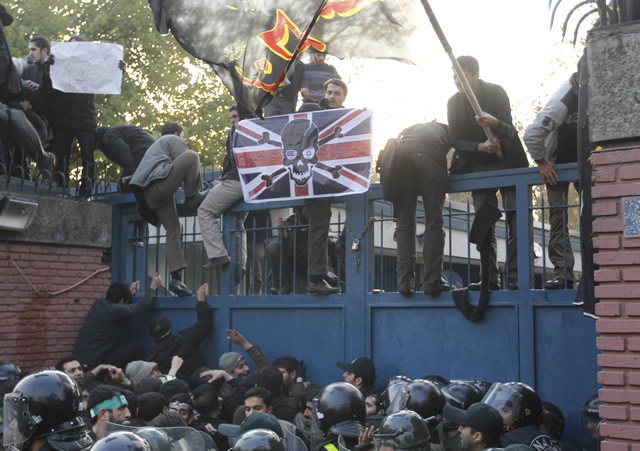Iran Orchestrates Attacks on British Embassy Compounds in Tehran
James Phillips /

Iranian student demonstrators climb over the wall of the British Embassy during a protest on November 29, 2011 in Tehran, Iran. UPI/Maryam Rahmanian
Iranian protesters illegally broke into two British Embassy compounds in Tehran today as police stood by idly, and the attack was broadcast live on Iranian television. It is unclear as yet whether British diplomatic personnel were harmed or taken hostage. Iran’s semi-official Mehr news agency reported that six British officials had been taken hostage but withdrew the story from its website minutes later without explanation.
Iran’s rogue regime once again has exhibited a flagrant defiance of international law by failing to protect the embassy compounds, and it undoubtedly orchestrated the politically charged action to punish the British government for escalating sanctions against it and to shore up its eroding domestic political support.
The embassy attacks came after Iran’s parliament voted Sunday to expel the British ambassador and downgrade relations with London after it imposed sanctions on Iran’s central bank last week. Yesterday, Iran’s Guardian Council took unusually swift action to approve the legislation, which called for the British ambassador to be expelled within two weeks.
Both of these actions were green lights for the embassy attacks, which were conducted by young Iranians, some of whom clutched pictures of Ayatollah Khamenei, Iran’s supreme leader. Others carried placards with a picture of Revolutionary Guards Quds Force Commander Qassem Suleimani.
Britain’s relations with Iran have been repeatedly marred by Iranian threats and confrontational tactics since Iran’s 1979 revolution. In 1989, Iran broke off relations with Britain after Ayatollah Ruhollah Khomeini issued an edict calling for the murder of British-Indian author Salman Rushdie for writing a book that Khomeini deemed to be blasphemous. Diplomatic relations were restored in 1990 and upgraded to ambassadorial level in 1999. In March 2007, Iranian Revolutionary Guards seized 15 British sailors and marines while they were patrolling the poorly marked Iran–Iraq maritime border and held them for 13 days.
Iran’s thuggish regime again is hiding behind “student demonstrators” as it did during the 1979 seizure of the U.S. embassy, when it took hostage American diplomats, holding 52 of them for 444 days. This time, the goals of the embassy attack are to punish Britain, deter other countries from following its lead to impose more sanctions on Iran, and attempt to rekindle the flagging revolutionary spirit of Iranians, who increasingly are fed up with the dangerous and bankrupt policies of the oppressive regime.
International tensions have been rising over Iran’s prohibited nuclear weapons program and its support for terrorism. On Saturday, two Revolutionary Guard generals issued separate threats against Israel and Turkey, warning that if Israel launched a preventive strike against Iran’s nuclear program, Tehran would target Israel’s nuclear facilities and also target NATO missile defense facilities that Turkey agreed in September to host in its territory.
Earlier this month, a mysterious explosion destroyed an Iranian military base, killing a general in the Revolutionary Guards who was the “chief architect” of Iran’s ballistic missile program.
Iran’s Revolutionary Guards also may be behind today’s launching of a rocket attack across the Lebanese–Israeli border, where its Hezbollah allies have clashed repeatedly with Israel.
Clearly, Iran’s Islamist dictatorship is becoming increasingly threatening to a wide range of other countries, including the United States, where it was caught red-handed in October, plotting to assassinate the Saudi ambassador to the United States in his favorite Washington restaurant, which could have also killed many Americans. What has been the Obama Administration’s reaction to all of this? We still await a concrete response.
